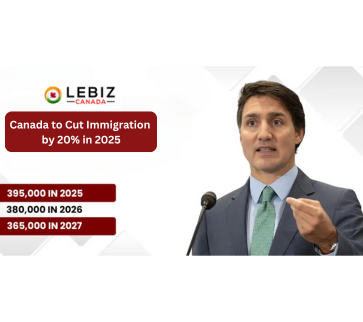The Canadian government recently unveiled its updated immigration targets for the next three years, reflecting a strategic shift in policy with a gradual decrease in permanent resident (PR) admissions. In 2025, Canada plans to welcome 395,000 new immigrants, which will decrease to 380,000 in 2026 and 365,000 by 2027. This reduction marks a 20% cut from previous goals, as the government aims to manage population growth sustainably. With a focus on balancing economic needs and infrastructure limits, the updated Canada immigration policy changes underscore a commitment to sustainable growth while addressing national challenges.
The government has set out the following breakdown of permanent resident admissions for the next three years:
| Immigration Category | 2025 | 2026 | 2027 |
| Total PR admissions and ranges | 395,000 (367,000 – 436,000) | 380,000 (352,000 – 416,000) | 365,000 (338,000 – 401,000) |
| French-speaking admissions outside of Quebec | 8.5% (29,325) | 9.5% (31,350) | 10% (31,500) |
| Economic Immigration | 232,150 (215,000 – 256,000) | 229,750 (214,000 – 249,000) | 225,350 (207,000 – 246,000) |
| Family Reunification | 94,500 (88,500 – 102,000) | 88,000 (82,000 – 96,000) | 81,000 (77,000-89,000) |
| Refugees, Protected Persons, Humanitarian and Compassionate, and Other | 68,350 (63,500 – 78,000) | 62,250 (56,000 – 71,000) | 58,650 (54,000 – 66,000) |
Key Impacts and Changes in Policy
Focus on Economic Immigration
Despite the overall reduction, economic immigration remains a primary focus. The Canada immigration cut 2025 affects overall numbers but keeps economic immigration relatively strong, with targets decreasing only modestly, from 281,000 to 232,000 for 2025. Canada continues to prioritise high-skilled immigrants, aiming to attract talent via programs like the Canadian Experience Class (CEC) and Express Entry. Approximately 40% of applicants in these categories are expected to transition from temporary resident status to permanent residency, reinforcing Canada’s objective to foster a high-skilled workforce. The Canada immigration policy for permanent residency 2025 is strategically structured to ensure that skilled professionals continue contributing to the economy, even amid reduced immigration targets.
Changes in Provincial Nominee Programs (PNP)
The updated immigration targets bring substantial changes to the Provincial Nominee Programs (PNP), which previously had a target of 110,000 for 2024. Now, PNPs are set to admit 55,000 immigrants annually for the next three years, signalling a major shift from provincial discretion to federally managed high-skilled programs. This aligns with Canada’s goal of focusing on economic growth through skilled immigration, making the 2025 immigration reduction Canada policy more centralised. Such adjustments in Canada’s immigration policy updates signify a push for more skilled labour migration, crucial for addressing labour market demands and fortifying sectors requiring specialised skills.
Temporary Resident Levels: A Strategic Adjustment
For the first time, Canada is also limiting temporary resident admissions, setting targets to regulate population density and reduce strain on public services like housing. By 2026, temporary residents are expected to make up 5% of the total population, down from the current 7%. This reduction includes lower admissions in student and worker categories, notably with fewer work permits issued under the International Mobility Program (IMP). The adjustment is intended to balance the demand for skilled workers with the capacity of infrastructure, marking a notable shift in Canadian immigration policy news. The Canada immigration reduction for international students 2025 and the limitation on temporary worker admissions are designed to alleviate housing pressures and better manage urban density, reflecting a holistic approach to sustainable growth.
The government has proposed the following breakdown for admissions of temporary residents in Canada for the next three years:
| Temporary Resident (TR) Category | 2025 | 2026 | 2027 |
| Total TR Arrivals and Ranges | 673,650 (604,900 – 742,400) | 516,600 (435,250 – 597,950) | 543,600 (472,900 – 614,250) |
| Workers | 367,750 | 210,700 | 237,700 |
| Students | 305,900 | 305,900 | 305,900 |
Balancing Economic Needs and Long-Term Growth
Prime Minister Justin Trudeau and Immigration Minister Marc Miller have emphasised the importance of these Canada immigration policy changes in maintaining economic competitiveness and addressing infrastructure constraints. This 2025 immigration reduction Canada is part of a broader plan to balance economic growth with sustainable development, positioning Canada as a destination for high-skilled talent while managing resources effectively. By prioritising sustainable policies, the government is addressing economic needs without compromising infrastructure quality, signalling a robust approach to growth.
Impact on Economy and Job Market
The new Canada immigration limit 2025 is expected to have mixed impacts on various sectors. While the reduction might lower the immediate influx of labour, focusing on skilled and high-demand workers will likely sustain economic benefits. The Canada immigration cut impact on jobs could streamline the labour market by prioritising sectors with shortages, though it may challenge some industries reliant on larger workforce numbers. Additionally, How Canada’s immigration cut affects jobs and Canada’s immigration cut impact on the housing market are critical areas of interest for policymakers and stakeholders, as they navigate the balance between growth and sustainability.
Key Insights for Immigration Aspirants
For those aiming to navigate Canada PR process 2025 under the new policies, understanding these shifts can be pivotal. The best immigration consultants for Canada 2025 policy can provide guidance tailored to the updated framework, especially given changes affecting Canada family sponsorship cut 2025 and work permit adjustments. For prospective skilled workers, the Canada immigration cut impact on skilled workers highlights the importance of focusing on high-demand industries and utilising programs like Express Entry.
